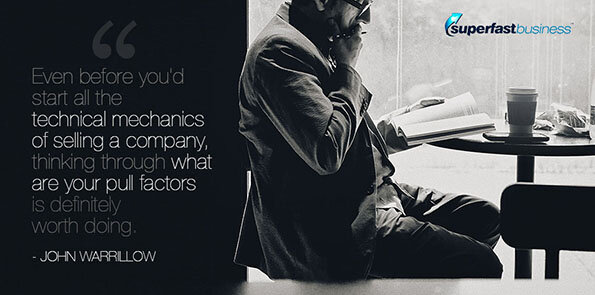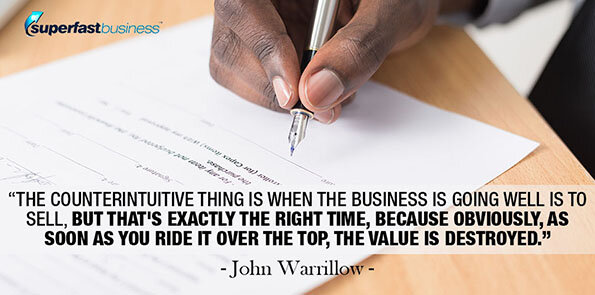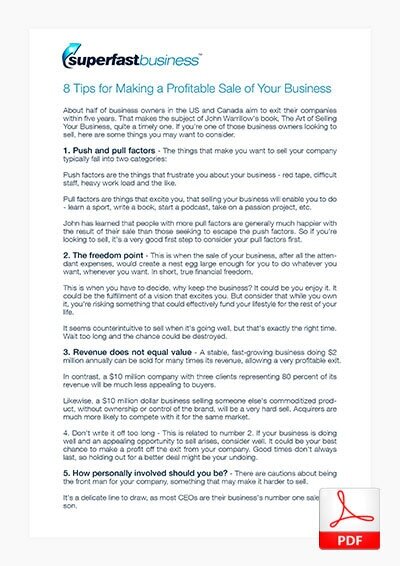John Warrillow's book, The Art of Selling Your Business, tackles a timely topic. Many business owners are looking to exit their companies within five years. What are the considerations, both from the seller's and the buyer's perspective?
John generously shares time and expertise in his second appearance on SuperFastBusiness. Tune in for some essentials of a profitable change of ownership in your business.
Podcast: Download (Duration: 45:35 — 41.9MB)
Get Notified Of Future Episodes Apple Podcasts | Spotify | Amazon Music | Android | Blubrry | Gaana | TuneIn | Deezer | Anghami | RSS | More
Podcast highlights:
01:17 – Catching up with John Warrillow
03:41 – Why half of business owners want out in five years
09:25 – The factors that push and pull
15:08 – When $10 million revenue is the goal
19:33 – What you want, what you’re doing, and when to let go
21:33 – Beware of writing it off too long
25:14 – How much personal involvement should you have?
27:59 – Consider what it’s worth in the buyer’s hands
32:20 – The earnout that could become a flameout
37:26 – The risk of financing with debt
40:50 – Between the covers of The Art of Selling Your Business
Make smart decisions for your business with help from James
John Warrillow is well-known for his Value Builder System. This modularized methodology helps business owners increase the value of their companies by up to 71 percent. He also wrote Built to Sell, on creating a business that can thrive without you and that you can sell.
Catching up with John Warrillow
When John first appeared on our show in March 2015, he had just published Automatic Customer: Creating a Subscription Business in Any Industry. This has become like a textbook to James, who works with many recurring subscription business owners.
Since then, John has launched Built to Sell Radio, a podcast on which he’s interviewed hundreds of business owners on their exits. From there, he’s gone on to his own podcast, now ranked by Forbes among the top 10 for business owners.
Why half of business owners want out in five years
John’s latest book is The Art of Selling Your Business. It comes out at a time when half of business owners look to sell their companies in the next five years.
To get this information, John and his team compared two sets of business owners. Those who, about eight months before the pandemic, completed their initial intake questionnaire, and those who had done it eight months into the pandemic.
What they discovered was greater pessimism among the latter group, many of them expecting their sales to be down. And more interestingly, many had pulled forward their sell-by date by 20 percent, meaning more were now planning to sell.
In Canada and the United States, says John, it was tradition to pass on a family business to the kids, typically the first son. But as a result of the pandemic, very few business owners want to do that. More are in favor of selling to a third party.
It is John’s hypothesis that running a business in the US has become so stressful that people simply would not want to pass it on to their children. There are many who wish they’d sold in 2019 and want to avoid the same mistake in 2021.
The factors that push and pull
Before selling one’s business, what should a business owner consider? John says you need to think about what you’re going to do next. And he talks about push and pull factors.
Push factors are things that frustrate you about your company, red tape, stubborn employees, and the like.
Pull factors that are things you’re excited to go do – learn to surf, write a book, start a podcast…
What they’ve learned, says John, is that the people with more pull factors are much happier with the result of their sale than those with mainly push factors.
“Someone could sell their business and still be unhappy.”
Interestingly, too, it doesn’t matter how much they sell the business for. John talks in his book about a man who sold for between two and three times profit. He was very happy.
When asked the reason, he said, “You know, when I was 30, I decided by the time I was 40, I wanted to live on a sailboat. And that was on my vision board.” He spent a decade building his business, sold it on his 39th birthday, and now lives on a sailboat.
 That, says John, was a pull factor. He was so fixated on the idea of living on a sailboat that selling for a relatively modest multiple was fine with him. So even before you’d start all the technical mechanics of selling a company, thinking through what are your pull factors is definitely worth doing.
That, says John, was a pull factor. He was so fixated on the idea of living on a sailboat that selling for a relatively modest multiple was fine with him. So even before you’d start all the technical mechanics of selling a company, thinking through what are your pull factors is definitely worth doing.
John speaks also of what’s called the freedom point. This is when the sale of your company, after tax and after you pay your broker, your M&A professional, would create a nest egg large enough that you could do whatever you want, whenever you want to – effectively, true financial freedom.
The question there becomes, why keep the business? You could say you enjoy it, that it fulfills a vision you’re excited about. But remember, says John, every day you own a business that could effectively fund your lifestyle for the rest of your life, you are like a gambler at the poker table, putting all the chips in the center.
 The counterintuitive thing is when the business is going well is to sell, but that’s exactly the right time, because obviously, as soon as you ride it over the top, the value is destroyed.
The counterintuitive thing is when the business is going well is to sell, but that’s exactly the right time, because obviously, as soon as you ride it over the top, the value is destroyed.
Has John been tempted to sell the Value Builder System? He has, and there have been offers. He feels, however, like he is able to do the things he wants to, irrespective of whether he sells. Value Builder is not his entire network, and more a passion business for him. If it ever amounted to 50, 60 or 70 percent of his net worth, however, it might be a lot of risk on.
“When your business is worth a big part of your net worth, it does beg the question, is it time to diversify?”
When $10 million revenue is the goal
James says it explains his own approach to business. He could have a much bigger and more saleable company than he has now. But since he’s been more heavily focused on building licensing revenue and royalty income on a subscription basis, to some extent, he’s living the life he wants to live now as well, and it wouldn’t make that much difference.
Many people come into James’s coaching with the vision of making $10 million in revenue. Is that realistic for most people in internet marketing, or have they not given it enough thought?
 John refers to the saying, revenue is vanity. He would encourage anybody to think about why $10 million is an important number for them, and what it will do for them, because a $10 million business that’s got three clients that represent 80 percent of the revenue is largely a worthless business.
John refers to the saying, revenue is vanity. He would encourage anybody to think about why $10 million is an important number for them, and what it will do for them, because a $10 million business that’s got three clients that represent 80 percent of the revenue is largely a worthless business.
Equally, if the company is just basically reselling someone else’s product, where you don’t have ownership of the brand, you don’t have control, it’s a commoditized product, nobody’s going to buy that business.
John recently had a podcast with Rob Wall, who started a company called Drip. He built it up to an ARR (annual recurring revenue) of $2 million, when he reached the freedom point. Given his negative churn rate and speed of growth, he figured he could sell it for between nine and 14 times revenue. So he did, and had an incredible exit. His $2 million business was worth infinitely more than a lot of $10 million businesses.
The $10 million thing, says James, also speaks to a point of John’s that a lot of people have their identity tied to their business. It’s who they are. And when they sell it, they’re empty, because they haven’t detached from it as a separate thing.
What you want, what you’re doing, and when to let go
John agrees, and while there are four steps to detachment, the first and most important is figuring out your pull factors. If you’re excited to start another company, build a charity, write a book, you’re going to sink your teeth into that.
 As entrepreneurs, he says, we are, for the most part, wired to act, to do. We’re not wired to sit on a rocking chair on our porch, drink a glass of lemonade and talk about the way it was in the past. If that’s your vision, that’s not going to be happy.
As entrepreneurs, he says, we are, for the most part, wired to act, to do. We’re not wired to sit on a rocking chair on our porch, drink a glass of lemonade and talk about the way it was in the past. If that’s your vision, that’s not going to be happy.
James recalls his grandfather, who up till he passed ran a timber brokerage that he loved, and that gave him a lot of purpose.
The balance between what you want to do and what you’re actually doing, and where the point to let go is, is an interesting one. John suggests a vision board. Maxwell Maltz, too, talked about visualization. It’s a great idea to spend time thinking about what you want your life to look like, and then articulating your business to be a vehicle to get you there.
Beware of writing it off too long
John can give examples of people who put off selling too long. Rand Fishkin, for instance, once guested on his show. Rand built up his business, Moz, up to $5 million in revenue, at which point he got a $25 million offer from HubSpot founder Mark Halligan.
Rand thought he would hit $10 million that same year, and wanted $40 million to sell. Halligan refused, and they parted ways.
Rand later raised capital, went into different businesses and products, and got distracted. He fell into depression and was removed as CEO of his company. The venture capitalists who invested in his business had preferred shares, meaning they were guaranteed a preferred return, before Rand got anything, in the event of a sale.
When John spoke with Rand, his net worth was about $800,000. And the offer with HubSpot, which was a cash and stock deal, would likely be north of $200 million.
How much personal involvement should you have?
Personalizing a brand can increase conversions and actually serve to differentiate a business. It might, however, also make a business harder to sell. What is the right approach?
It’s certainly a delicate line, says John. Most CEOs are their number one salesperson. Think Elon Musk, Steve Jobs, Bill Gates.
Bill Gates, however, focused on the products in the business, tried to have that sort of halo effect accrue to the business, not necessarily to him personally. So there are things you can do. First of all, make a clear line between your company and your name. Focus and invest in the brands that you’re building.
You can be your company’s best asset, but over time start placing the spotlight on the company. One practical thing you can do is make sure you’re not the first face on your website that people see. If you build in a management team, consider alphabetizing the names of the team as opposed to arranging them in hierarchy.
Consider what it’s worth in the buyer’s hands
As an entrepreneur looking to sell your business, your job is to tell the story of what it can become in the hands of the buyer. That, says John, is the definition of a strategic acquisition, when an entity that has assets, a distribution channel, lots of salespeople, lots of stores, has got something that they can use to make your business worth more if they own it.
He gives the example of Jay Steinfeld, who founded Blinds.com. Jay took on the challenge of selling a complicated product like window blinds online. It took some time, but he eventually got his business up to $100 million in revenue, at which point it was bought by Home Depot, a big box retailer in the US.
Home Depot acquired Blinds for two reasons. One, they wanted to lead in every category they retailed, and in blinds they were at number two behind Blinds.com. Two, they wanted to apply what Jay and his team knew about selling complicated products to the rest of their products online.
That was an example of a strategic acquisition, where that business was worth much more in their hands than it was in Jay’s.
The earnout that could become a flameout
John talks in his book about earnouts. Typically, you’re not getting paid for your business in cash upfront. More often, you’ll have some skin in the game or delayed payment terms, or you’ll have to stick around and do certain things or satisfy certain conditions.
There are lots of different ways that you could be asked to participate in a transition period. The most common is an earnout, where there is a set of goals you agree to try to achieve a certain period of time down the road. If you achieve them, you get an extra payment.
The proportion of your deal that’s at risk depends on how risky buying your business appears to the buyer. A common scenario is 60 or 70 percent cash up front and 30, 40 percent earnout. Enough that it hurts to walk away from the earnout, but not so much that you don’t at least monetize some of your company.
“As entrepreneurs, we don’t thrive working for somebody else most of the time.”
This can be a challenge for entrepreneurs. After working for yourself, imagine being essentially an employee in a company you owned for however long after you sell.
John speaks of Rod Drury, who founded Xero with money he got in an earnout. He had created an email archiving product called Aftermail, and sold it to two Fortune 500 companies for $1 million each. He then sold the business to a systems integrator for $35 million. Fifteen million of that was upfront; the rest was an earnout.
What Rod said he would have done differently was to buy himself six months – six months to rest up and digest what he’d accomplished in selling. That six months would also allow him to meet people at the company, network with the executives, essentially prepare for when the earnout clock started.
Rod basically missed an early gate, which he realized made it impossible to hit the earnout. So he took his $15 million and started Xero.
The risk of financing with debt
John tells also of a podcast guest who sold his business to a private equity group. The game of private equity groups is to buy a business and finance it with a lot of debt. They’ll typically buy 60, 70 percent, and make you carry 30, 40 percent of the equity into a new entity. The reasoning is that the 30, 40 percent will be worth more when the business is rolled up with others and the entity sold somewhere down the road.
In the case of John’s guest, he sold 60 and carried 40. They put a load of debt on the company, on the new entity. End of the story was the business failed to meet its debt obligations. It couldn’t make its payments; they brought in executives to try to fix it, but they couldn’t.
The new entity went bankrupt, and John’s guest lost everything on the whole 40 percent. None of the 60 percent was at risk, but everything in the 40 percent was gone.
“The job of the entrepreneur is to create competitive tension for the business.”
John suggests creating competitive tension for the business, meaning multiple offers, so that you have some control over the deal terms that are important to you. If you’re negotiating with one acquirer, one private equity group as an example, they know that, and they’re likely to take advantage of that and give you a deal that’s not favorable.
If you’ve got three or four buyers at the table, you can say, “I know you want me to carry 40 percent of the equity, but really, I’m comfortable carrying 10.” It doesn’t mean you’re not going to participate in some sort of transition period, work for example as VP for a year, but you’re not giving up everything in equity carry.
Between the covers of The Art of Selling Your Business
James finishes off the interview with an overview of John’s book, which he highly recommends. Had he read it before, he says, he would have sold his businesses better.
John talks in the book about building value and what buyers are looking for. He also speaks about being happy with exiting, something definitely missing in some of the books that James has read.
There are really great ideas on timing – why you shouldn’t stag a high market or try and sell in a recession, and some good arguments back and forth about the tempo of a deal. Then in chapter four there’s advice on doing a slow reveal. Chapter five is about positioning and making sure you’re going to capture the most value.
Chapter six is about the three different types of acquirers, a few mentioned in the podcast. Seven is identifying a buyer – this is really when you want to maximize the sale.
“The natural buyer for your company is likely to be five to 20 times the size of your business today.”
Eight, John talks about the 5-20 rule, meaning the natural buyer for your company is likely to be five to 20 times the size of your business today. By definition, it’s a David and Goliath scenario. You’re going to be smaller than them, so you’ve got to find a way to punch well above your weight when you sell your company.
Chapter nine talks about teasing the sale – you’ve got to build the value without just giving it all away. And 10, critically, there’s an element of confidentiality. There’s multiple warnings in the book about if you do things the wrong way, you’ll basically be fleeced.
John talks about some of the terms you’ll want to know. You don’t want to walk into a deal like a rookie. And then chapter 11 discusses how long you carry this sort of secret with your team and the market and how you might communicate.
Chapter 12 is all about knowing your number. This is a conversation James has with my coaching students. One of the questions asked in their onboarding diagnostic is if they’re looking to sell. Almost all of them say no. When James says, “Well, what if I wrote you a check for $20 million today? Would you sell?” They say, “Yes.” James says, “So you would sell. So let’s figure out the number.”
Then John goes into negotiation tips, talking about setting the price, setting the terms, the earnout versus flameout, how to nudge the price up a little bit. And then the concept of freedom.
If you’re interested in John’s book, you can head over to BuiltToSell.com/selling.
Plan and structure your profitable business journey inside JamesSchramko membership
Enjoyed the show? Access all the episodes when you subscribe on iTunes










Leave a Reply